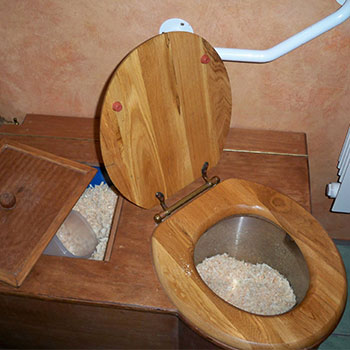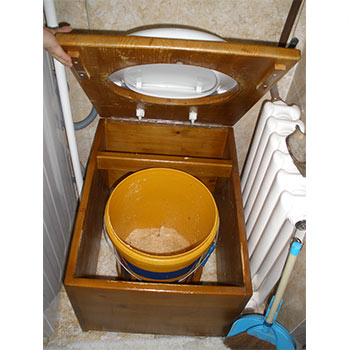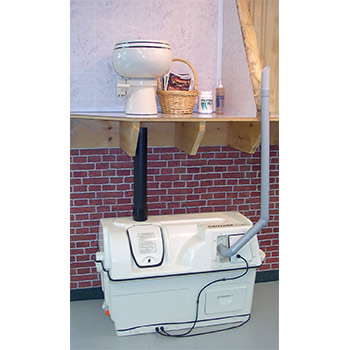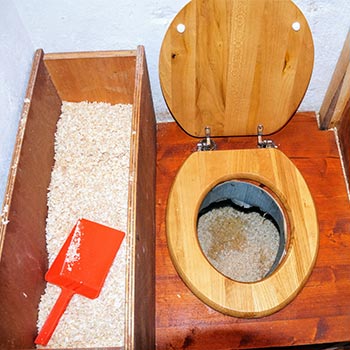Is a DIY composting toilet worth it? In this detailed guide, find out how you can build one cheaply and effortlessly.

The average person throws away 9 times their body weight in waste every year. What is worse, nearly 30% of that waste is food scraps and yard waste that could be used to create compost.
Compost is organic material that you can add to the soil to help plants grow. People have used it alongside manure to enrich the soil with nutrients that plants use, but also to improve moisture retention in regions affected by drought.
It may come surprising that human waste can also be successfully composted by using an easy-to-make composting toilet that everyone can build.
So, let's take a look at how you can build simple DIY composting toilet and take a bold step towards sustainability.
What Is A Composting Toilet?
A composting toilet is a defecating system that collects human waste and turns it into compost. It’s a great way of turning refuse into a resource.
It’s not an outhouse, latrine, or privy. If you build it right, it gives off no foul odor.
Since it does not require any plumbing, you can build it almost anywhere, and since there are no sewer drains, it doesn't add to pollution.
A composting toilet combines human feces with dry materials such as sawdust, crushed leaves, or wood ash. You dump this mixture onto your composting heap, and straw and high heat will do all the rest.

Source: Dale Calder
This way, you can safely use composted “humanure” in your garden, even for fruit trees and vegetables.
Types Of Composting Toilets
Self-Contained
In self-contained composting toilets, the compost system is enclosed within the toilet, beneath the bowl.
This type of composting toilet is best suited for small homes, boats, and recreational vehicles (RVs). It's also commonly used in seasonal dwellings like cabins and cottages.
If you have the time to do it yourself, however, you can easily add one to your full-time residence.

Central or Remote
If you live in a large home, using a central or remote composting toilet could be a better option.
This version takes both pee and poop to a central composting system that is at another location (and not beneath the bowl). In many cases, this location is in the basement or even outside the house.
If you have a large remote system, you can channel several of these in your home.
On the outside, these central composting toilets look like traditional toilets with a bowl.

The Sun-Mar Centrex 2000 (Source: Green Building Supply)
How Does A Composting Toilet Work?
A composting toilet works by separating the liquid from solid waste, mixes the solid with sawdust or similar absorbent materials, and then turns it to compost. Whether you choose self-contained or split type DIY compost toilet the other, they both follow a similar concept and consist of these parts:

The composting chamber needs to be lined with carbon materials like dried peat moss or coconut fiber. This is to keep proper carbon/nitrogen balance for bacteria to do their work.
In a simpler variant, just throw in a trowel of sawdust each time you use the toilet.
Urine drains into a removable container, while solid waste falls through a manual flush door into the composting chamber. If the bowl gets dirty, use a spray bottle with a mix of water and vinegar to flush the remains and keep the business clean.
Now you need to stir the compost up. Turn the spider handle that is attached to the agitator bar to mix the feces with the existing compost and carbon material. If you’re using a DIY toilet with a simple plastic bucket, just throw another layer of sawdust.
Once the toilet is full, remove the urine container and empty it in a safe manner. For the composted part, you need to follow your state or local guidelines to dispose of compost. The best place to start is your state’s department of health website.
If there is any leftover compost matter clinging to the sides of the composting chamber, rinse the container using a garden hose with a high-pressure attachment. After you’ve cleaned it, tip the water onto your outdoor compost heap. Dry the bucket with a rag and spray the interior with vinegar.
Remember not to use chemical cleaners as their residue may kill the good bacteria that break down the waste into compost.
How To Build A DIY Composting Toilet
You'll be able find many composting toilets DIY plans online, but if you want to build the simplest and the most effective variant with a plywood frame and a 5-gallon bucket, you're going to need:
Materials
Tools
Steps
Step 1. Build The Box
Your DIY composting toilet needs to be comfortable as this is where you’ll be releasing your humanure day after days. If it’s comfortable, it will make the experience more enjoyable. When it comes to toilet comfort there are two key things:
Height — Naturally the taller the toilet, the easier for you to sit and stand up. However, the doctors say that the more you squat, the better you may empty your bowels. Find the ideal height by trying to sit and stand from objects of different height to get the ideal measure.
Toilet seat — This is entirely up to you, just make sure it’s durable and comfortable.
To build the frame of your composting toilet, you need to decide on the dimensions, by considering the available space. Remember that it needs to include the size of the toilet seat.
Cut out six pieces of plywood for the top, bottom, and four sides of the box. Attach the pieces together using a pocket hole jig to make the box stronger and to hide all those screws from plain sight.
Step 2. Cut The Hole
You need to keep the top section of your plywood box loose so you can access the bucket. On the other hand, you’ll need to cut a hole in the center for the waste to fall inside. You can use the toilet seat as a template:
- Place it on top of the plywood
- Open the seat lid
- Take a pencil and draw around the entire inside circumference
You can freely cut the circle a bit wider to give yourself more wiggle room. Start cutting by drilling a hole somewhere on the line so you can insert the jigsaw blade. Unless you’re a seasoned DIY carpenter, your hole is not going to be perfect, so use a file to soften the rough edges and finish them with sandpaper.
Once the box is done you may choose to stain or paint it to give it more character.
Step 3. Add The Urine Separator
Attached to the top, the urine separator channels the urine into a separate container in your DIY composting toilet. This helps compost toilets neutralize the smell, but also makes it easier to dispose of urine and keep the solid waste bucked drier.
Screw the urine separator to the underside of the plywood lid, at the front.
A composting toilet is not an outhouse, latrine, privy, or anything like that. If you build it right, it gives off no foul odor.
Step 4. Install The Toilet Seat
Place the toilet seat assembly on top of the hole you’ve just cut. Mark the drill holes with a pencil. Use a strong screwdriver to drill small holes for the toilet seat hardware, making sure the holes are tight enough so the screws don’t get loose with use.
Step 5. Give It Legs
While the whole plywood box can rest on the floor by itself, it’s always better to give it legs. Bathrooms are wet places, and sooner or later there’s going to be water on the floor, and plywood and water don’t play nice.
Place each 2x4 wood at the four corners of the plywood box and screw together. Place the whole thing on the floor to see if it stands firmly. If any of the legs are shaking, check the screw to find any additional spacings.
Step 6. Get The Buckets
To complete your composting toilet DIY project you need to find buckets of the right size. One for number 1s and the other for number 2s.
An ideal container for urine is long and narrow. If you have trouble finding something like that, a 3.5-liter plastic pot would be enough for a day.
As for the solid waste bucket, you can use 5-gallon (about 20 liters) plastic buckets. Be sure you have at least three buckets in rotation — two can be full at all times and one being used.
Step 7. Add Absorbents Into The Bucket
For the last step, add a few inches of absorbent materials into the bucket. You may use dried leaves, wood ash, or sawdust (hardwood sawdust is the best). The sawdust soaks up the excess moisture but also neutralizes the bad odors.
Here's a video that shows all the steps I've outlined above. Now the steps here may be in a different order, but they all add up to a similar final result. Check it out below.
Reasons For Building A Composting Toilet
Greener Alternative To Septic
Septic tanks are expensive, and in certain layout and land conditions, the use of a septic tank would not be possible at all. Not to mention environmental regulations that may prohibit the use of septic tanks where you live. A DIY composting toilet, on the other hand, lets you deal with your stuff on your property in the greenest possible way — by turning it into food for plants.
Conserves Water
Even in this time and age, there are regions that struggle with water scarcity, and not all of them are in developing countries. When compared to traditional toilets that waste up to 5 gallons of water on a single flush, for a DIY composting toilet described here, you need very little to no water.
Even when sewage makes it to the treatment plant, it takes a huge amount of money and energy to clean all that wastewater, and the process must be repeated over and over as the water is cycled back through people's toilets. I think that you should really make people understand how stupid it is to poop into clean water.
Cecilia Lalander, Environmental Engineering Researcher at the Swedish University of Agricultural Sciences in Uppsala
No Plumbing Required
If you’re looking into compost toilet DIY tutorials, chances are that you plan to use one where plumbing is not available, such as an outdoor cabin. A composting toilet is also a great option for an old building, where plumbing is either inefficient or non-existing. From an environmental point of view, having a composting unit makes much less impact than you having to tear out the old and running new pipes through the building.
Inexpensive
While you can go and buy a ready-made composting toilet, this is all about being self-sustainable and making do with materials you have at hand, with minimum waste. The 5-gallon bucket version with a plywood frame and urine separator will set you back about $10. You won’t be creating any waste and won’t have to pay for someone to install it.
Odorless Option
When compared to an outhouse, a DIY composting toilet has a significant advantage — you don’t have to deal with foul odors in your property. Helped with the carbon material, the whole composting process is carried out by bacteria under aerobic conditions. The final product is eco-friendly odorless compost which you can use in your garden.
FAQ
Yes, you can make your own composting toilet. A composting toilet is easy to build with a few basic hand and battery tools. All you need are a few sheets of thick plywood, a toilet seat assembly, screws, and a bucket with the absorbent material. You can even create a simpler unit by using a medical toilet seat.
Yes, you can pee in a composting toilet. In that case, you’ll have to use more absorbent material, like sawdust, to neutralize the odor, as urine and feces also smell much worse together. Sawdust is rich in carbon and you need more of it to balance the extra nitrogen content, so composting can take place.
No, composting toilets don’t smell bad. If you follow the instructions and make sure there is enough absorbent material in the bucket you won’t have to deal with bad smell. If you want to be extra sure, you can install a vent with a small 12V computer fan that activates every time you open the lid.
Yes, you can use human feces for compost. Keep in mind that it’s much easier to compost feces from a toilet with a urine separator. While some municipalities recommend using this type of compost only for flower beds, if you use a hot compost heap, you can use it on your vegetable patch safely as well.
You can get rid of composting toilet waste by emptying it onto your outdoor compost bin. If you used plenty of damp sawdust or peat moss, the bucket won’t smell bad, and you can rinse it with a garden hose, dry it, and spray it with vinegar. No chemical cleaners needed.
Yes, you normally use toilet paper with a composting toilet. Toilet paper won’t decompose as quickly as feces so it will be visible long after the matter has broken down. You can use any type of paper, but keep in mind that marine and RV paper will compost the quickest. You should never throw diapers, wipes, and tampons in a compost bin.
You can dump a composting toilet on your composting heap or apply it directly to your garden. Between November and April you shouldn’t apply compost to your plants, so dump the content of your bucket into a composting bin or heap. In warmer months, empty the toilet directly at the base of shrubs and flower beds.
No, you don’t need electricity for a composting toilet. The best thing about compost toilets is that they can be used off-grid, with zero power, emissions, and pollution. If you use one in your home and want to eliminate any chance of bad odor, you can use a small 12V computer fan for venting.
Yes, earthworms can eat human waste. They live off any organic matter that is composting. When given human excrement, they will digest it and convert the remaining material into their excrement, called worm castings. Worm castings are among the best balanced natural plant foods there is.
You can make a compost toilet not smell by making sure there’s always enough absorbent material in the bucket. For this, you can use hardwood sawdust, dried peat moss, dry leaves, or coconut coir. You can also install a small computer fan to vent any lingering odors outside.
Conclusion
A DIY composting toilet is a great alternative to a chemical toilet or outhouse. It’s odorless, eco-friendly, and can fit almost anywhere you need a restroom.
Above all, these toilets are among the most sustainable options today. They need very little or no water, so they are great if you want to minimize your water consumption. They produce no pollution, as there’s no septic tank that you need to empty, and you don’t add to municipal sewage.
This type of toilet is also easy to build: if you can handle standard house tools, then you should start building a functional composting toilet today.



Great read! ♻️ While focusing on DIY composting toilets, don’t forget the modern touch. A ‘Flutter On-Demand Home Services App’ can provide a convenient solution for maintaining these systems efficiently. Innovation meets sustainability!
This is really helpful.
This will be really useful during camping.
I did this during summer camp. I also put dry leaves so as to lessen the moisture.
Pingback: Living Without Running Water by Vickie Bryant - Stand Independent
Might as well try this. This could be really useful during camping.
This is really useful especially when you go camping. Thanks!
That is great, thanks.
Great.
Pingback: 20 Actionable Earth Day Tips To Make A Real Change
I like the idea but it seems there’s so much work involved, I’m all for going green and all but.. whatever floats your boat, I guess.
After the initial setup, there is a little bit of work involved in emptying the toilet periodically. But you are paid for that work by not having to install a septic system, in water savings, in valuable fertilizer, in a healthier planet, and in the luxury and convenience of being able to put a toilet anywhere you want. All rooms in your home could have their own toilet, as well as the basement, garage, and backyard, if you wanted. Now, you can minimize the work somewhat by having a several buckets with lids. Then, as each bucket fills up, put the lid on and set it aside. You can take them all out to the compost heap at once, as it takes about as much time to empty a dozen buckets as one. It’s just like emptying the trash. (BTW, you can use your full buckets to dispose of kitchen scraps, too. Just lift the lid on a full bucket and dump in your peelings, coffee grounds, food scraps, etc.)
As for the initial setup, the video on this webpage of the $4 toilet shows the most complex diy composting toilet I have ever seen. A simpler option is the “loveable loo” by Joseph Jenkins. (Go to humanurehandbook.com). He sells a kit you can put together yourself, but I’d recommend trying it out yourself first. Just cut a 1×12 into four pieces of proper length, glue and nail them together to form a box, attach four legs of 2×2 or 1×2 inside the box, then attach a hinged lid of plywood to the top of the box and cut out a hole in the lid to allow the top of the bucket to just poke through the lid. Attach your toilet seat over the bucket and you’re done. Once you understand the basic design, you can elaborate on it and make your box as fancy as your skills allow.
Don’t bother with a urine separator. Just poop and pee and wipe into the bucket like you normally would. When you’re done, toss a couple of scoops of cover material over your deposit. You can pee several times into the bucket without putting in more cover material. I use leaves for cover material. Just run your lawn mower over a pile of leaves and pile them up outside in a heap for later use. If you live near woods, you can go out and scoop up a few buckets of well rotted leaf mould anytime.
I absolutely cannot understand why this was done, because it has been shown for a long time that this is not the most effective method of fertilization, because it will take a lot of effort. You will have to build this toilet, and it will take a lot of time to build it, then you will have to do fertilization, which is also not the most pleasant thing. As a result, you will spend a lot of effort, while getting absolutely nothing. Such diy should be treated more skeptically, although the idea itself is very cool.
Pingback: How to Build a DIY Composting Toilet | Green Home Gnome
Pingback: 15 DIY Composting Toilet Ideas to Build a Composting Toilet
GreenCitizen is an environmental conservation company providing you with information, services, and products to help you live a sustainable life.
Follow Us
Join Our Newsletter
Quick Links
Green News
Green Directory
Green Store
Blogs
Most Popular
Sustainable Living
Renewable Energy
Business & Polices
Environment
Product Review
Services(United States)
For Businesses
Business Pickups
Data Destruction
Build Wide Pickups
Product Destruction
For Homes
Electronics Recycling Drop-off
Mail-in Recycling
Hard Disk Destruction
How to Recycle ?
Useful Links
About Us
Contact
Careers
Customer Reviews
Our Customers
Press Room
In The News
LEED Reporting
E-waste Crisis
Data Security
Global Dumping
Harmful Effects
Styrofoam Recycling
Polyurethane Foam Recycling
Why Data Security ?
Copyright © 2023 · All Rights Reserved · GreenCitizen
Privacy Policy | Affiliate Disclosure